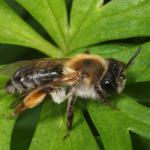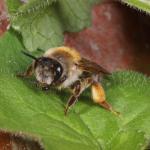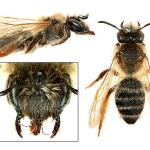One of the largest Andrena species in Britain. It is a uniformly brown bee with reddish yellow hind legs, especially noticeable in females, where the yellow scopal hairs accentuate this colouring. It belongs to the group with a raised crest around the rear of the propodeum; this can often be seen with a hand-lens when examining specimens in the net. Males may be found patrolling along hedge-lines and around isolated bushes, flying at about head height, presumably searching for newly-emerged females.
Predominately a southern bee, with only sporadic records north of the Wash-Severn line. There are no confirmed records from Scotland or Ireland.
It is widely distributed in southern and central Europe.
This species is listed in Falk (1991) as Notable A (now known as Nationally Scarce).
Found in a wide range of habitats.
Univoltine; late March to June.
May nest singly or communally in areas of sunny bare ground, often of a sandy nature.
Visits a wide variety of flowers.
Nomada fulvicornis Fabricius is a cleptoparasite of this species. Both males and females may rarely be stylopised by Stylops perkinsi Pasteels, Cook (2019)
2023




